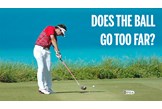|
This autumn saw a record smashed on the European Tour, when Nicolas Colsaerts hit a 447-yard drive – the longest ever recorded on the circuit. It once again ignited the debate: Does the modern ball go too far? We investigate…
What’s the issue?
The defining moment of this year’s Masters was Bubba Watson’s 366-yard drive over the corner of the 13th hole, leaving himself a sand wedge into what used to be a challenging par 5. It was a shot that divided opinion. Some thought it was fantastic and were delighted to witness such a brave drive. Others saw it as final proof that the ball is going too far and making a mockery of the game and many of its finest courses. “Where is the game going?” asks Gary Player. “When are the USGA, the R&A and the PGA going to have more vision and cut the ball back by 50 yards?”
But is it really going further?
In 2014, Bubba was the biggest hitter on the PGA Tour, averaging 314.3 yards. He was one of 25 players to average 300 yards or more. But averages for the biggest hitters have been around 315 yards for the last decade, while the average driving distance for all pros has been floating around 290 yards for years. Look back a little further, and distances do change dramatically. Back in the mid-1990s, even the longest players were only averaging 283 yards, which would rank them among the shortest hitters of today.
So what’s changed?
The dramatic jump in distance happened around the turn of the millennium. By 1997, persimmon woods had completely disappeared from the professional game. In 2000, Titleist launched the Pro V1, and everything changed. It quickly became the most-played ball on Tour, and average driving distance shot up by six yards in a single season, leading the USGA to release a statement saying “any further significant increases in hitting distances at the highest level are undesirable”.
But can’t more distance be a good thing?
When Bubba hit that famous drive, the fans were screaming in excitement and awe, not dismay. Most handicap golfers get a bigger buzz from launching a long drive down the middle than from any other shot in golf. “I hope they don’t roll back the ball,” says Donald Trump. “It’s a tough game; you’ve got to make it a little bit easier.” And have you ever met a club golfer who wants to hit it shorter?
And golf’s not all about distance, is it?
While no one could deny that being able to hit 330-yard bombs helped Rory and Bubba take home three of the year’s Majors, big hitters don’t win every week. Jim Furyk is no.5 in the world, despite being 155th in driving distance. Certain courses favour big-hitters, while others place a premium on accuracy. It doesn’t matter how far you can hit it if you can’t get it in the hole. If distance was everything, long drive champions would be winning Majors, not trying to hit 450-yard bombs down a 50-yard wide grid.
|



